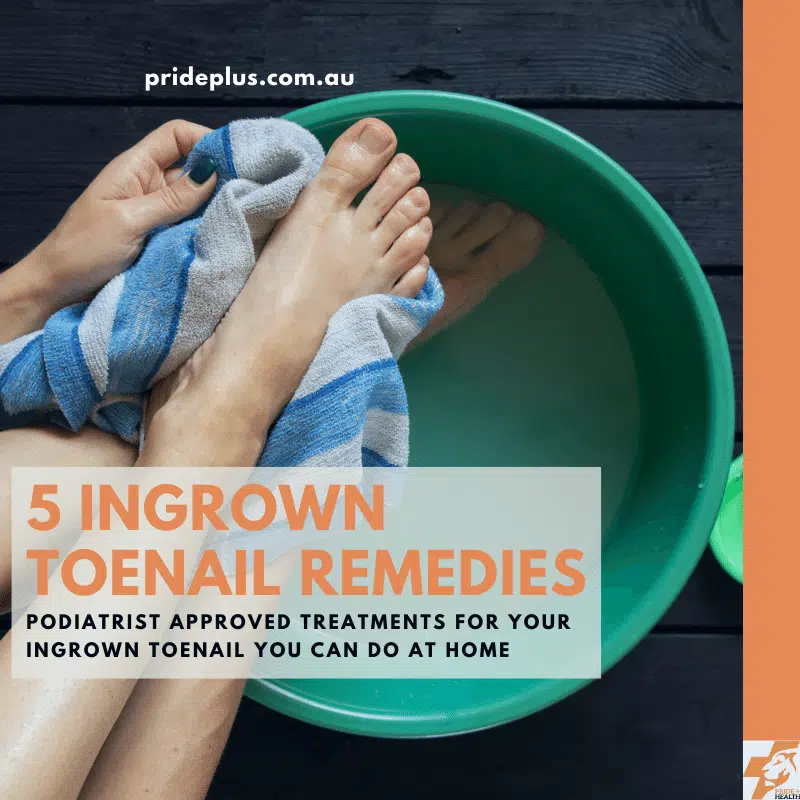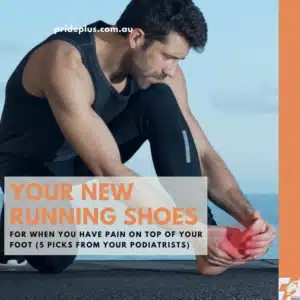In order to fix your ingrown toenail, you’re going to need to do a few things at home.
For many, the important step of seeing a podiatrist will come a day or two after painful ingrown toenail symptoms start. Your podiatry session is still going to be necessary to resolve your ingrown toenail for good. Also your podiatrist and you will work on preventing an ingrown toenail from coming back.
But that doesn’t help you at 11pm at night when the bed sheets are pressing on your sore toenail.
Here’s 5 ingrown toenail remedies you can do at home to get some relief.
- Warm water soak (with 4 extra options to supercharge your toe bath)
- Wear the right shoes
- Dress you ingrown toenail
- Take pain relief
- Use antibiotics if necessary
If you’re on top of these, you’ll have the best chance of avoiding an infection (the serious symptom of ingrowing toenails that can put you in hospital) and settling your pain as quickly as possible.
This list is what I wish all my podiatry clients had the chance to do before coming into their session in the clinic. They will help you be as safe and as comfortable with your ingrowing toenail as possible.
Words of warning… If you have an infection, poor circulation, diabetes, or already tried these at home you must see your podiatrist ASAP. Deteriorating ingrown toenails can be serious limb threatening conditions under some circumstances.
A Warm Water Soak
Soaking your ingrown toenail in water water helps ease the pain initially as well as remove the nasties.
To do a warm water soak at home, grab a clean container or partially fill the bath with warm water. Place your toes in the water and gently soak and wipe away at the ingrowing edge with a clean cloth or face washer. (I guess it’s now a foot washer?)
The water will lift away debris from your nail edge and the warmth can be particularly soothing. Your warm water soak is one of your important ingrown toenail remedies you can complete at home, up to 3 times per day. It usually takes around 10 – 15 minutes to complete.
An important reminder. Be sure to gently but thoroughly dry in between your toes when finished.
You can also supercharge your warm water soak with the following:
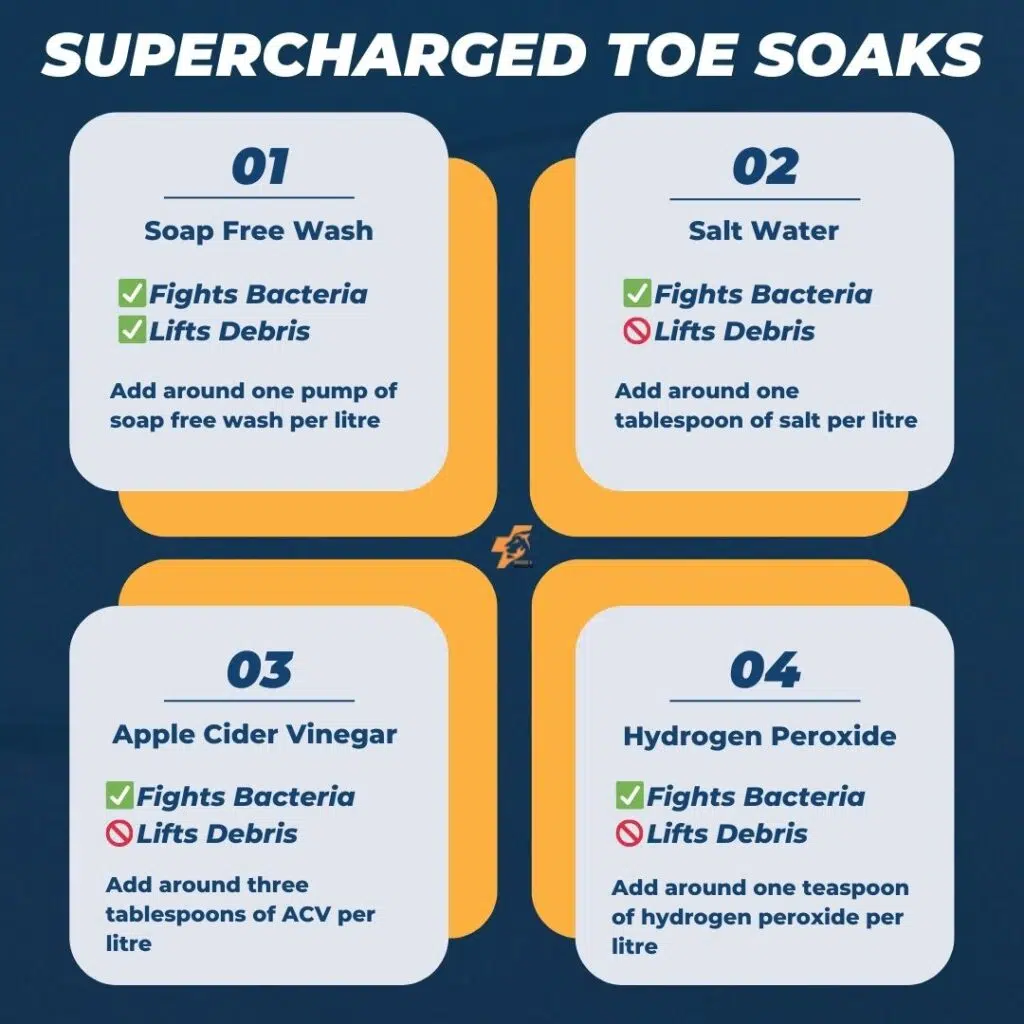
Soap-Free Wash Bath
Using a pH balanced soap free wash will help you lift more debris, bacteria and foot grime away from your painful ingrowing nail.
The soap free wash has the benefit of being pH balanced to your skin which means that it doesn’t sting like soap can. Also, you’ll not be asking your skin to work hard to secret acids after bathing like soap does.
The bonus that makes a soap free wash the pick of these is that they contain a surfactant which is the slippery stuff in soap that helps lift stubborn grime. The difference between washing your dishes with plain water and with dish soap is the same difference you get when you add soap free wash to your ingrown toenail remedies.
Salt Water Bath
Adding salt (table salt) to your warm water bath can help cleanse and lift away bacteria from your ingrown nail.
The salt water provides an environment that is less hospitable to bacteria to thrive compared with plain old tap water. It’s not a huge difference but any marginal gain when treating an ingrown toenail is worth it. You’ll need to mix around a tablespoon of salt per litre of water.
If I had a choice between salt water or a soap free wash however I’d go for the soap free wash as the best of the bath based ingrown toenail remedies.
Apple Cider Vinegar Bath
Your hippy aunt that recommends apple cider vinegar for every ailment is finally right. Kind of.
If you’re looking for empirical evidence that apple cider vinegar is effective for ingrown toenails you’ll be disappointed. Sorry Aunty. But that doesn’t mean that those who swear by the anti-inflammatory and antibacterial properties of apple cider vinegar aren’t completely wrong.
The pH of apple cider vinegar will help slow the rate of many bacteria from multiplying, which is very good for your ingrown nail. Adding around 3 tablespoons of apple cider vinegar per litre of water is the best dosage.
Hydrogen Peroxide Water Bath
Adding hydrogen peroxide to your warm water bath is going back to the old times with this remedy.
Hydrogen peroxide is a natural disinfectant with its pH of around 6.2 being close to the 5.5 of your skin. Similar to a soap free wash in action this means that the bacteria will find it harder to move from colonisation to infection. A teaspoon of hydrogen peroxide per litre has been considered a safe dose however it would need to be a real “emergency” situation for me to consider this as a treatment.
Soap free washes are the safer option as they are already the right pH for your skin AND they have a surfactant to help lift away stubborn grime.
Wear The Right Shoes
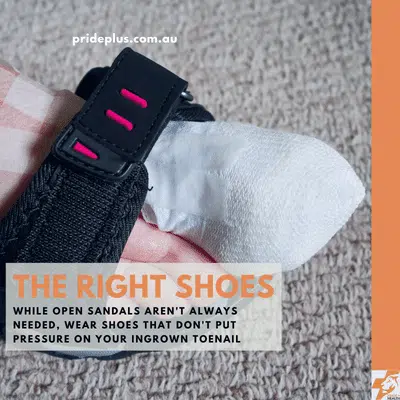
Have you noticed that some shoes cause more pain from your ingrown toenail than others?
Some of your shoes will be narrower than others. Have firm uppers. Higher heels. These features all increase the pressure underneath your toenails as it pushes your toes back towards those ingrowing edges.
Wear shoes that are more comfortable that have features that lean in the other direction. Your best shoes for your ingrown toenails will have:
- Open toes
- Low heels
- Soft, wide and deep fitting uppers
These might be your best pair of pillow slides or slippers. Or they could be your runners. Wearing the right shoes is imperative to get that acute ingrown toenail pain down and is one of those ingrown toenail remedies you can act on straight away.
Dress Your Ingrown Toenail
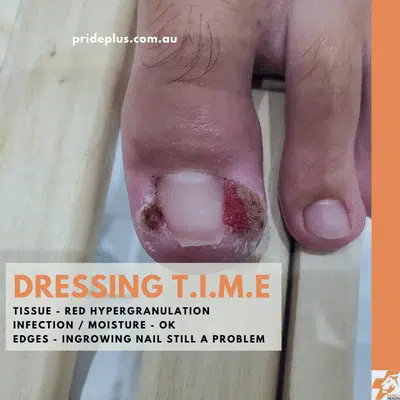
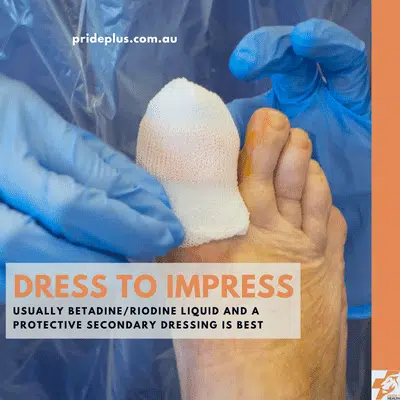
Dress for success!
Dressing your toenail is the best way to treat a local bacterial colonisation, prevent an infection and provide the fastest wound healing environment. In the foot biz (actually us podiatrists don’t really call it the foot biz maybe it will catch on?) we use the following acronym as a reminder.
TIME. Tissue, Infection, Moisture, Edges.
What this means for you as you follow these ingrown toenail remedies is that you’ll need to match the dressing to the TIME status of your sore toe.
With your ingrown toenail Tissue references what the open lesion looks like. Pink / Red skin is the norm here.
Infection is whether the bacteria on your skin is within it’s normal range or running wild as a spreading infection. As feet are generally a bit more germy than the rest of the body it’s best to consider an infection likely to occur and use an appropriate antimicrobial to cover. By far the best is betadine liquid (another brand is riodine, either is fine). The liquid gets into the nooks and crannies of your ingrowing nail edge (where the ointment does not). It also has the added benefit of addressing moisture levels.
Which brings us to Moisture. Just like goldilocks, your ingrown toenail doesn’t want to be too moist or too dry for its fastest healing. Betadine / Riodine liquid works well here as it acts as an astringent to dry out a wet ingrown toenail.
With Edges and ingrown toenail it’s about the edge of the toenail. Is it still pressing into the skin like a splinter? It needs to come out. This is where a trip to your podiatrist is the best course of action.
Take Pain Relief When Needed
Pain can be managed with safe, mild doses of oral pain relief.
Paracetamol (panadol), diclofenac (voltaren) and ibuprofen (nurofen, advil) are three different over the counter medications you can use to reduce pain as ingrown toenail remedies to do at home. All three come with different side effects so make sure you read the label and follow the directions.
Take Antibiotics When Necessary
Antibiotics that treat an infected ingrown toenail can be the difference between managing safely at home and a trip to the hospital.
But only if your ingrown toenail is infected.
When you follow these ingrown toenail remedies at home you’ll be reducing your pain and infection risk by washing away excess bacteria and fighting them off with antimicrobials. Antibiotics won’t help a non-infected ingrown toenail heal faster or feel better so you need to know for sure your toe is infected before you start taking them.
An infected ingrown toenail will have the following 3 telltale signs:
- Swelling of the toe, not just the ingrowing edge
- Redness (erythema) spreading from the ingrown edge away into the healthy tissue
- Pus and a funky smell.
If you have these signs then you should talk to your GP ASAP and get a prescription for a safe antibiotic to fight off that infection. You’ll still need to manage your nail well at home and follow these ingrown toenail remedies to fix it.
As you settle you follow these ingrown toenail remedies at home your pain and suffering should start to decrease. Don’t let that fool you into thinking everything is fixed though. The ingrowing edge will still be a problem, either straight away or as it grows back as your toenail grows.
No matter, there’s a way to fix ingrown toenails for good. It all starts with your trip to your podiatry clinic to see your podiatrist.
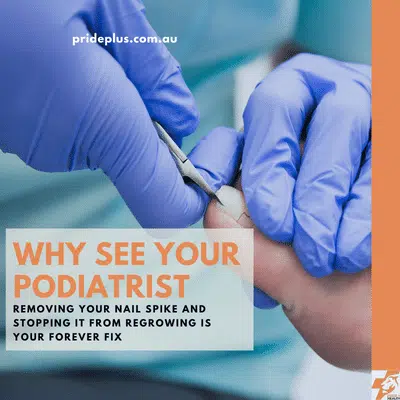
About the Author

Tim Mulholland is a podiatrist who’s suffered with an ingrown toenail himself. He knows the sharp, stabbing pain you feel when the sheets press on your toe. The pain from footy boots. The soothing sting of the betadine.
He’s also completed hundreds of ingrown toenail surgeries and thousands of consultations where he’s cleared the offending nail edges away from the skin. If you’d like to talk toenails, Tim – and his podiatry colleagues at PridePlus Health – are here to help.
Maybe your toenail has gone black rather than ingrown? Check this out.

